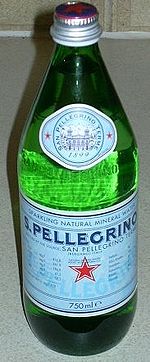S.Pellegrino: Difference between revisions
Jeff Silvers (talk | contribs) Removed misplaced "founded in" date. |
No edit summary |
||
| Line 1: | Line 1: | ||
{{ |
{{redirect|Pellegrino}} |
||
{{Infobox Bottled Water |
{{Infobox Bottled Water |
||
Revision as of 21:28, 13 May 2010
| Country | Italy |
|---|---|
| Source | San Pellegrino Terme |
| Type | Sparkling |
| pH | 7.7 |
| Calcium (Ca) | 181.0 |
| Chloride (Cl) | 57.5 |
| Bicarbonate (HCO3) | 239.0 |
| Fluoride (F) | 0.5 |
| Lithium (Li) | 0.2 |
| Magnesium (Mg) | 53.5 |
| Nitrate (NO3) | 2.2 |
| Potassium (K) | 2.5 |
| Silica (SiO2) | 7.5 |
| Sodium (Na) | 36.1 |
| Strontium (Sr) | 3.2 |
| Sulfate (SO4) | 459.0 |
| TDS | 960 |
| Website | www.SanPellegrino.com |
| All concentrations in milligrams per liter (mg/L); pH without units | |
San Pellegrino (also S. Pellegrino) is a brand of mineral water with carbonation added, produced and bottled at San Pellegrino Terme, in the Province of Bergamo, Lombardy, Italy. This water contains, in addition to hydrogen and oxygen (H2O) and carbon (in the carbon dioxide (CO2) carbonation), at least the following chemical elements in amounts of 100 or more micrograms per liter: calcium, chlorine, fluorine, lithium, magnesium, nitrogen, potassium, silicon, sodium, and strontium. The strontium is naturally occurring, not the radioactive strontium-90. Owned by Nestlé since 1997, San Pellegrino is exported to most countries in Europe, the Americas, the Middle East and Australasia, as well as to Japan and Hong Kong.
Production
The water may originate from a layer of rock 400 metres (1,300 ft) below the surface, where it is mineralized from contact with limestone and volcanic rocks. It emerges from three deep springs at a temperature of about 22 °C (72 °F).[1] The springs are located at the foot of a Dolomite mountain wall which favors the formation and replenishment of a mineral water basin. The water then seeps to depths of over 700 m (2,300 ft) and flows underground to a distant aquifer.
History

San Pellegrino mineral water has been produced for over 600 years.[2] In 1395, the town borders of San Pellegrino were drawn, marking the start of its water industry. Leonardo da Vinci visited the town in 1509 to sample and examine the town's "miraculous" water, later writing a treatise on the subject.[2] Analysis shows that the water is strikingly similar to the samples taken in 1782, the first year such analysis took place.
The earliest existing records show that 35,343 bottles were produced (5,562 of which were exported) in 1899. Nine years later, San Pellegrino was exported to the main European cities, as well as Cairo, Tangiers, Shanghai, Calcutta, Sydney, Brazil, Peru and the USA.
In 1932, the Aranciata orangeade variant was introduced. Containing San Pellegrino as its primary ingredient, the soda added concentrated orange juice. Today, San Pellegrino also produces various other flavors of carbonated beverages: Limonata (lemonade), Sanbittèr (bitters), and Chinò (chinotto).
In 1968, San Pellegrino appeared on the front cover of the British Sunday newspaper The Observer. On April 20, 1970, the company was renamed San Pellegrino SpA. Later that year, it became the leading beverage company in Italy. Throughout the 1970s and 1980s, the company continued to expand, and in 1988, San Pellegrino became the first Italian mineral water brand to be exported to France. That same year, San Pellegrino SpA was bought out by Nestlé. In 2003, the price of 75 cl San Pellegrino bottles reached US$10 in the restaurants of New York City, where 65,000 bottles are sold every day.[citation needed] In Italy, San Pellegrino is available in 1.5 L bottles for about one euro, the same for their Aranciata in most stores. Competitive orange drinks can cost even less. If artificial sweeteners are used, the price is about half that of the sugared varieties.
In 2007, German consumerism TV programme Markt reported that San Pellegrino contains uranium. Nestlé has been informed about this and responded that the uranium levels were common in both bottled and tap water and were below the harmful levels recommended by various governments and food health organizations. They say San Pellegrino is not for infants under 12 weeks of age.[3][4]
See also
Notes
- ^ "San Pellegrino". FineWaters. Retrieved 2007-02-22.
- ^ a b "S.Pellegrino Acqua Minerale History". San Pellegrino. Retrieved 2007-02-22.
- ^ Letters between Foodwatch and Nestle
- ^ Concentration of Uranium in various waters, including San Pellegrino
External links
- San Pellegrino Official website
- Aquadiv [1]
- Nestlé's description of San Pellegrino
- San Pellegrino Chinò website Template:It icon
- A picture of the available bottle sizes
